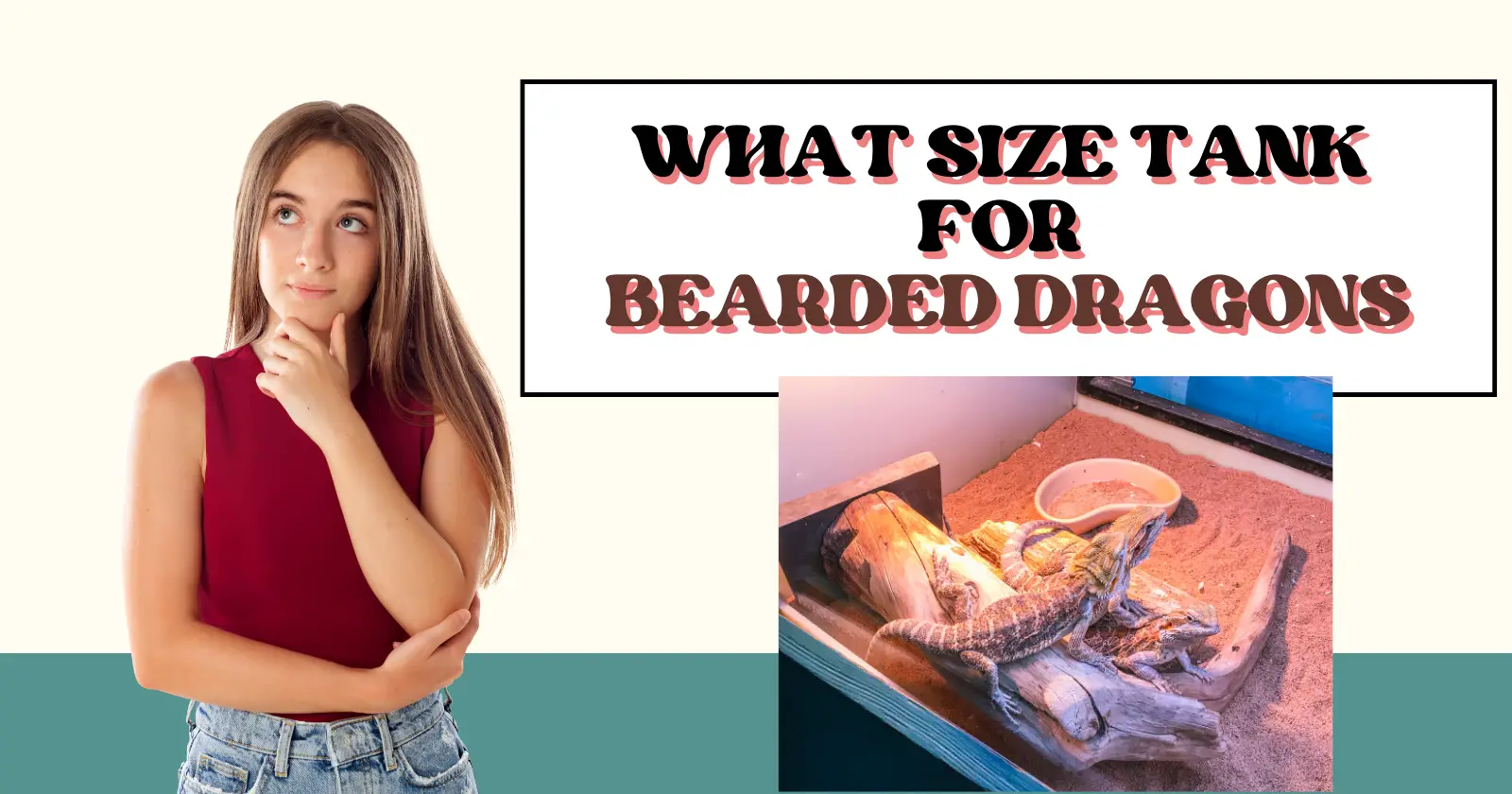Hey there! Planning the perfect bearded dragon tank setup? When it comes to housing adult beardies, considering their adult size is crucial (Same for Baby Beardies). Different types of tanks are available, with a minimum of gallons to accommodate their needs.
From wooden enclosures to single enclosures, pet stores offer a variety of options. Don’t forget to include an incandescent bulb for their bearded dragon cage. Let’s dive in and create a comfortable home for your Baby Beardies and adult beardies!
What Size Tank for Bearded Dragons: Ultimate Guide
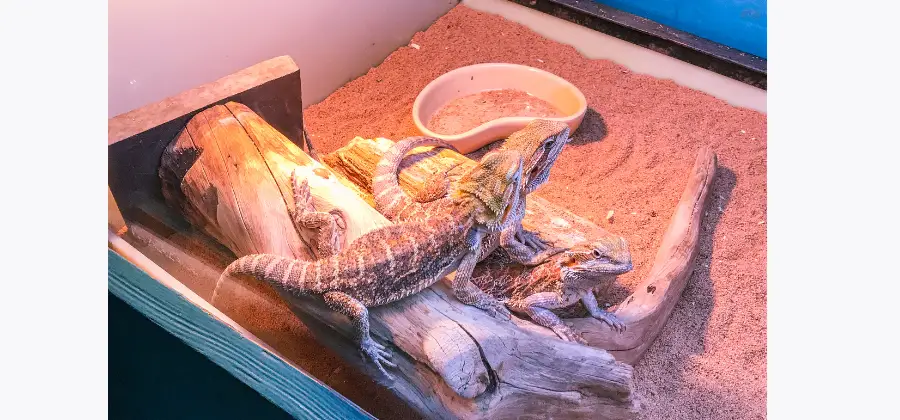
Bearded dragons are popular reptile pets known for their unique appearance and docile nature. As these intriguing creatures grow, it’s essential to provide them with a suitable living space to ensure their health and happiness.
The size of the tank needed for a bearded dragon varies depending on its age and size, as well as the specific subspecies.
For a juvenile bearded dragon, a 20-gallon tank is a sufficient starting point. However, as the dragon matures, it requires more space to move around and explore. An adult bearded dragon needs a minimum tank size of 55 to 75 gallons, preferably with dimensions around 36 inches in length, 18 inches in width, and 18 inches in height.
Larger breeds may require even more space, so it’s important to research your prospective pet’s specific needs in advance.
When setting up the tank, it is crucial also to consider the bearded dragon’s natural habitat and replicate its conditions as closely as possible. This includes providing appropriate lighting, heating, substrate, and hiding spots for the reptile.
Overall, providing the appropriate tank size and environment for your bearded dragon will contribute to its well-being and ensure a comfortable, happy life for your pet.
Understanding Bearded Dragons
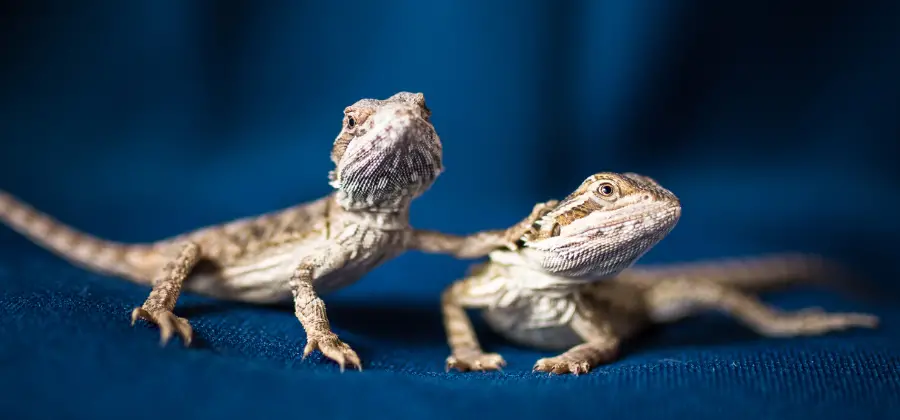
Natural Habitat
Bearded dragons are desert-dwelling reptiles native to the Australian desert. Living in an arid environment, they have adapted to thrive in the harsh conditions found in their native habitat. Their skin coloration provides them with camouflage when hiding among rocks and vegetation, while their spines aid in their defense against potential predators.
Understanding a bearded dragon’s natural habitat is essential for providing them with the right conditions in captivity. Emulating their desert environment can help to promote their overall health and well-being. Some key aspects to consider include:
- Substrate: Sand or a sand-like substrate can be used to mimic the natural ground found in the Australian desert.
- Temperature: Bearded dragons require a temperature gradient, with a basking area of around 98-100°F and a cooler area of about 80-85°F.
- Lighting: Provide adequate UVB lighting to support their health and help them metabolize essential nutrients.
Temperament
One of the reasons for the widespread popularity of bearded dragons as pets is their docile temperament. These desert lizards are generally friendly and easy to handle, making them suitable for reptile enthusiasts of all experience levels.
To further ensure their adaptability to life in captivity, it is important to provide them with ample space to roam and enough environmental stimulation.
In summary, understanding the natural habitat and temperament of bearded dragons is vital when providing them optimal care in captivity. Replicating their desert environment and considering their docile nature can result in a healthy and content pet for both novice and experienced reptile keepers.
Tank Size Requirements
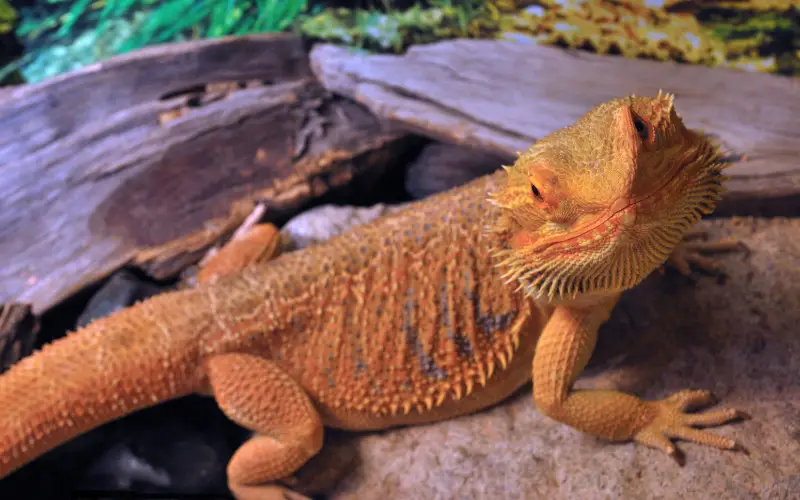
When providing suitable habitats for bearded dragons, it’s crucial to consider the appropriate tank size based on their age and growth stage. Choosing the right tank size ensures their comfort and contributes to their overall health and well-being.
Bearded Dragon Tank Size: Optimal Space for Baby and Adult Dragons
Baby bearded dragons, also known as baby dragons, require plenty of space to ensure their comfort and health. The size of the bearded dragon tank plays a crucial role in providing adequate room for their growth and preventing potential health issues.
From the smallest hatchlings to adult beardies, finding the right tank size is essential for their well-being. This guide will explore the importance of providing sufficient space, comfortable temperatures, and suitable tank features for these solitary creatures.
Let’s discover the ideal bearded dragon tank size that caters to their needs throughout different life stages.
Hatchlings
For baby bearded dragons, a smaller tank size is suitable for their initial growth stage. A 10-gallon tank can provide enough space for a hatchling to move around and thermoregulate without feeling overwhelmed.
As the baby beardie grows, it will eventually require a larger tank to accommodate its increasing size and activity needs.
Juveniles
As bearded dragons reach juvenile age, a larger tank is necessary to provide ample space for movement and basking areas. A minimum of a 20-gallon-long aquarium is recommended during this stage to ensure the beardie’s comfort and health.
When setting up the tank for a juvenile, create distinct temperature gradients, basking spots, and hiding areas for optimal growth and development.
Some key tank features for juveniles include:
- A 20-gallon long tank or larger to accommodate growth
- A basking area with a temperature range of 95-105°F (35-40°C)
- A cooler side with temperatures between 75-85°F (24-29°C)
- Proper UVB lighting for adequate calcium absorption and metabolism
- Appropriate beddings, such as reptile carpet or tile
Adults
Adult bearded dragons require the most space as they can reach a size between 18-24 inches in length. An enclosure of at least 40 gallons, preferably 50-75 gallons, is ideal for adult bearded dragons, giving them enough room to move about and bask comfortably.
Large tanks or the biggest tank will also support their activity levels, maintain proper temperature gradients, and reduce stress, contributing positively to their overall health.
Here are some vital tank features for adult bearded dragons:
- A tank size of 40-75 gallons with secure lids and ventilation
- A basking area with a temperature range of 95-105°F (35-40°C)
- A cooler side with temperatures between 75-85°F (24-29°C)
- Adequate UVB lighting
- A substrate that is easy to clean and gentle on their feet, such as reptile carpet or tile
- Proper hiding spaces and climbing areas for stimulation and exercise
In summary, providing an adequately sized tank for bearded dragons at each stage of their growth is essential to their health and wellbeing. Make sure to upgrade their habitat as they grow, and always monitor environmental conditions to ensure they are comfortable and thriving.
Types of Tanks and Enclosures
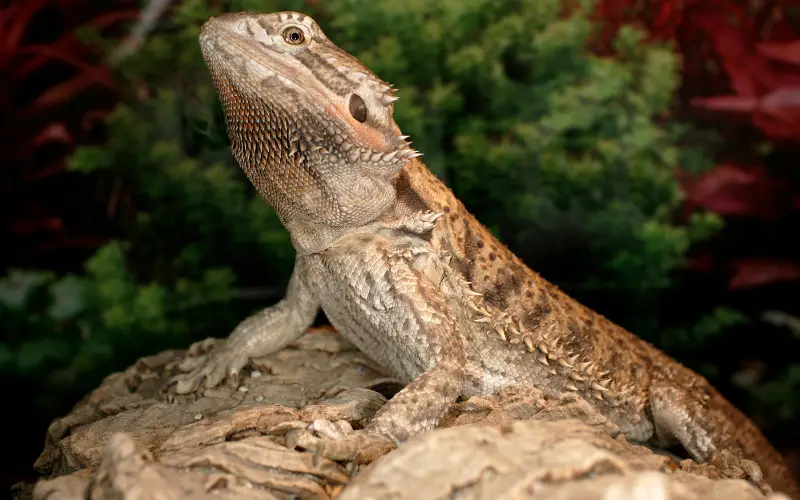
Bearded dragons, solitary animals, require suitable housing to thrive. The popular options are 120-gallon tanks or glass enclosures with removable acrylic doors and screen lids. These spacious habitats offer a perfect size for their wide range of sizes. Direct sunlight and food dishes are essential, making them a preferred choice in pet shops and stores.
Material Options
When it comes to housing a bearded dragon, there are several material options to choose from. Some popular choices include:
- Glass: Glass tanks are the most common enclosure for bearded dragons. They are easy to clean, provide a clear view of the pet, and are readily available. However, they may not provide the best heat retention and ventilation.
- Wood: Wooden enclosures can offer better insulation, which can be helpful in maintaining the appropriate temperature gradient. On the downside, wooden tanks can be challenging to clean and might require sealing to prevent damage from moisture.
- PVC: PVC enclosures are lightweight and easy to clean, though they may not provide the best visibility for your pet.
- Screen: These types of cages are suitable for well-ventilated environments and can provide good airflow. However, they may not retain heat well.
Ventilation and Lighting
Proper ventilation is crucial to ensure that your bearded dragon has access to fresh air and a comfortable environment. An enclosure with a screen top can be a good choice, as it allows for adequate airflow while still retaining some heat.
For lighting, bearded dragons need access to UVB light for the synthesis of vitamin D. A UVB bulb or tube should be positioned in such a way that your dragon can bask within 12 inches of the light source.
Additionally, heat lamps are necessary to maintain the optimal temperature gradient in the enclosure. A basking area temperature should typically range between 95-110°F, while the cooler end should be around 75-85°F.
Check out this Tank for Bearded Dragons:
Setting Up the Environment
Temperature Regulation
Bearded dragons require a well-regulated environment with a temperature gradient in their enclosure. This allows them to thermoregulate their body temperature by moving between warmer and cooler areas. To achieve this, you’ll need to establish a basking spot and a cooler area.
- Basking Spot: Create a basking spot where the temperature should be around 95-110°F (35-43°C). You can use a heat lamp, ceramic heat emitter, or under-tank heater to provide the required heat. Make sure to mount a thermometer near the basking area to measure and regulate the temperature accurately.
- Cool Area: On the cooler side of the tank, the temperature should be between 75-85°F (24-29°C). This allows your bearded dragon to move to this side if they need to cool down, helping them maintain their ideal body temperature.
Humidity Control
Bearded dragons are native to arid grasslands and require a low-humidity environment. To maintain optimal humidity levels, follow these guidelines:
- Use a hygrometer to measure the humidity in the tank. Aim for a range between 30-40% relative humidity.
- Provide adequate ventilation to keep the air circulation smooth and prevent humidity buildup.
- Avoid using a substrate that retains moisture. Instead, opt for a dry substrate, such as reptile carpet, newspaper, or non-adhesive shelf liner.
Providing Space for Activities
The size of your bearded dragon’s enclosure determines the space they have for activities and exploration. The minimum size tank for a single adult bearded dragon should be:
- Length: 36-48 inches (90-120 cm)
- Width: 18-24 inches (45-60 cm)
- Height: 18-24 inches (45-60 cm)
Providing ample space allows your bearded dragon to exhibit their natural behaviors and promotes overall health and well-being. Additionally, ensure that there are some hiding spots and climbing opportunities, such as logs, branches, and hammocks, in the enclosure.
Remember, when setting up the environment for your bearded dragon, close attention must be paid to temperature regulation, humidity control, and providing enough space for various activities. By doing so, you will create an environment that keeps your bearded dragon healthy and comfortable.
Enclosure Decorations and Accessories
Substrates
When setting up a bearded dragon enclosure, selecting an appropriate substrate is crucial. Several options are available, including:
- Reptile carpet
- Ceramic tile
- Newspaper
- Sand (caution: can cause impaction if ingested)
It’s important to choose a substrate that is easy to clean and provides a comfortable surface for your bearded dragon to explore. Avoid using materials that may cause impactions, such as small loose substrates.
Basking Rocks and Logs
Bearded dragons are diurnal and love to bask in warm temperatures, so providing basking rocks and logs is essential. Ensure that the basking area reaches an ideal temperature of 95-105°F (35-40°C). You can create a basking area by incorporating:
- Flat rocks
- Branches
- Logs
Remember to securely place basking rocks and logs so they do not topple or cause accidents.
Hiding Spots
When not basking, bearded dragons enjoy having hiding spots to retreat to for some privacy and security. You can create hiding spots using:
- Half logs
- Ceramic hides
- Rock caves
Ensure that the hiding spots are appropriately sized, allowing your bearded dragon to safely enter and exit without getting stuck.
Climbing Options
Bearded dragons are semi-arboreal, which means they enjoy climbing. Offering various climbing options can help keep your pet mentally and physically stimulated. Some climbing options include:
- Branches
- Hammocks
- Ledges
- Shelves
Ensure that all climbing structures are securely placed within the enclosure to prevent accidents and help your bearded dragon stay active and engaged.
Health and Wellbeing
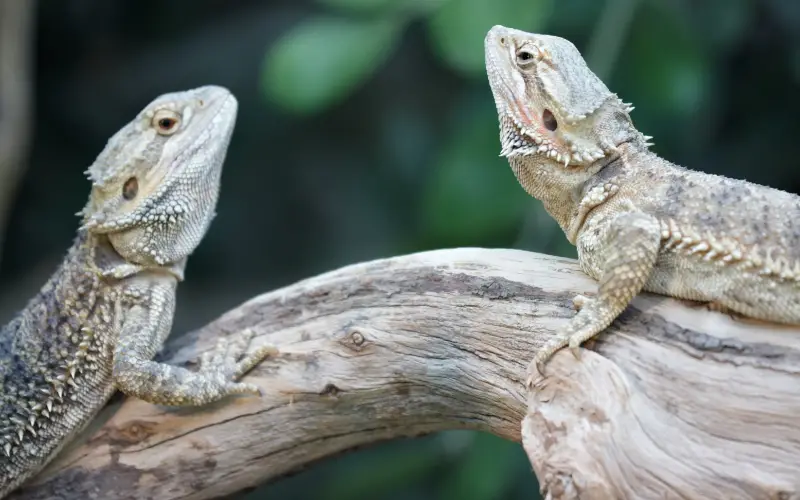
Signs of Stress
Bearded dragons can show signs of stress when their environment is not suitable. Some indicators of a stressed bearded dragon include:
- Glass surfing: Pacing back and forth or clawing at the glass walls of the tank
- Loss of appetite: Not eating or showing a reduced interest in food
- Darkened coloration or stress marks: Appearing darker or displaying stress marks on their belly and legs
- Agitation: Exhibiting excessive activity or frequent attempts to escape
One common cause of stress for bearded dragons is inadequate space. A suitable tank size is essential for their overall well-being.
Juvenile bearded dragons require a minimum of a 40-gallon tank, while adults need at least a 75-gallon tank for sufficient space.
Nutrition and Diet Requirements
A balanced diet is crucial for the health of your bearded dragon. Their nutritional requirements include:
- Insects: Crickets, roaches, or worms should be gut-loaded and dusted with calcium supplement before feeding
- Greens: Leafy greens, such as collard greens, kale, and dandelion greens, should make up a significant portion of their diet
- Vegetables: Squash, bell peppers, and green beans can be given as additional variety
- Fruit: Serve fruit, such as berries, apples, and melons, in moderation as an occasional treat
It’s essential to provide the appropriate food size for your bearded dragon, as feeding them prey that is too large can lead to health problems such as impaction. A general rule of thumb is to feed insects no larger than the space between your bearded dragon’s eyes.
Common Health Problems
Several health problems can affect bearded dragons, stemming from improper care or nutrition. Some of the common issues include:
- Metabolic Bone Disease (MBD): A result of insufficient calcium intake or lack of proper UVB lighting, causing weakened bones and deformities
- Impaction: A blockage in the digestive system caused by ingesting indigestible material or excessively large food items
- Parasites: Internal parasites can affect their digestive system, while external parasites such as mites can cause stress and skin issues
- Respiratory infections: Often caused by poor husbandry practices, such as incorrect temperatures, humidity, or a dirty environment
Proper care, adequate tank size, and a balanced diet can help prevent these common health problems and contribute to a happy and healthy bearded dragon.
Watch The Perfect Bearded Dragon Enclosure Setup for ANY Budget!
Budget Considerations
When planning the bearded dragon setup, budget plays an important role. To provide the best environment for your pet, it’s crucial to consider various factors such as time, tank size, and husbandry requirements.
Bearded dragons need a tank that provides adequate space for movement and exploration. The ideal tank size depends on the age and size of your bearded dragon.
Juvenile dragons can thrive in a 20-gallon tank, but as they grow, they will need at least a 40-gallon tank (preferably 75-gallon or larger for adults). Keep in mind that larger tanks may come at a higher price.
To make the most of your money, consider these tips when setting up your bearded dragon’s habitat:
- Prioritize essentials: Focus on providing the necessities for your bearded dragon first, including a heat source, UVB light, substrate, and hiding spots. Once you’ve purchased the essentials, you can add decorations and additional features gradually over time.
- Shop sales and second-hand: Keep an eye out for sales on tanks, lights, and other supplies. Additionally, check online marketplaces for used tanks or equipment to save money. Just ensure that the products are still in good condition and safe for your pet.
- DIY options: With a little creativity and research, you can craft some aspects of your bearded dragon’s habitat yourself. For example, you may opt to build a custom enclosure or design your own climbing branches and hiding spots.
- Consider ongoing costs: The initial setup isn’t the only cost of keeping a bearded dragon. Don’t forget to factor in ongoing expenses such as food, vitamins, and replacement lights. Proper husbandry and regular maintenance will lead to a healthier bearded dragon and less unexpected costs.
By taking these budget considerations into account, you can create a comfortable and suitable environment for your bearded dragon without breaking the bank.
Remember that investing in the proper care and housing for your pet will ultimately lead to a happier, healthier life for your scaly companion.
Factors to Consider for Tank Selection
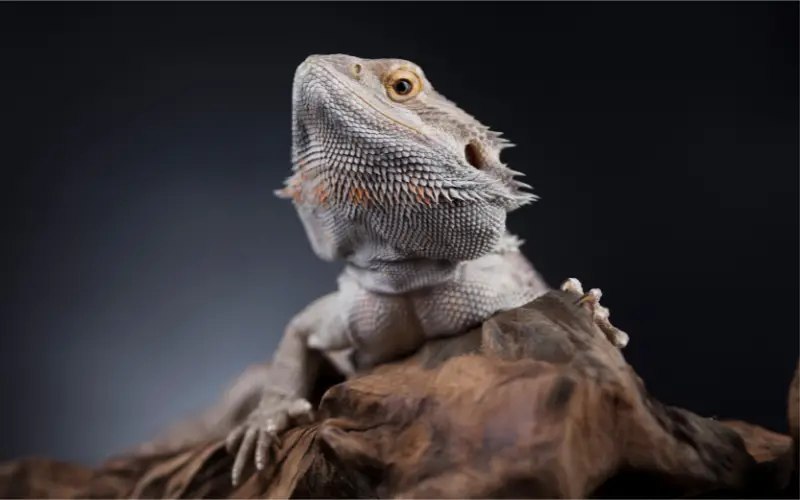
Bearded dragons are ectotherms, meaning they rely on their environment to regulate their body temperature. Therefore, the size and setup of their enclosure play a crucial role in their overall health and well-being. Let’s discuss some key factors to consider for tank selection:
Room to Move
It’s important for a bearded dragon’s tank to have enough space for them to move around comfortably. A larger tank increases their physical activity and ensures proper digestion. Keep in mind that an adult bearded dragon can grow up to 2 feet in length, so providing ample space is essential.
- Juveniles (under 12 inches): 20-gallon tank minimum
- Adults (12 inches and above): 40-gallon tank or larger
As the bearded dragon grows, you may need to upgrade to an even larger tank.
Range of Temperatures
Creating a proper temperature gradient in the tank is essential for bearded dragons. Since they need to regulate their body temperature by moving between warm and cool spots, it’s crucial to have a tank large enough to accommodate this temperature range.
- Basking spot temperature: 100°F-110°F (38°C-43°C)
- Cooler side of the tank temperature: 75°F-85°F (24°C-29°C)
A larger tank size allows for a more effective thermal gradient to be created, providing the bearded dragon with the proper range of temperatures for its well-being.
Stunted Growth
A too-small or overcrowded tank can lead to stunted growth in bearded dragons. This is because they need ample space to move freely, engage in natural behaviors, and avoid excessive stress. Stunted growth can negatively impact their overall health and lifespan.
Digestion
Bearded dragons need appropriate space and temperature ranges within their tank to aid in their digestion. A tank that is too small or improperly set up can lead to digestive complications, which can harm their overall health.
In summary, the main factors to consider when selecting a tank for a bearded dragon include ensuring there is room for them to move comfortably, providing a proper temperature gradient, preventing stunted growth, and facilitating digestion.
Following these considerations will help ensure that your bearded dragon has a healthy, thriving environment in which to live.
Other Information for Bearded Dragon Owners
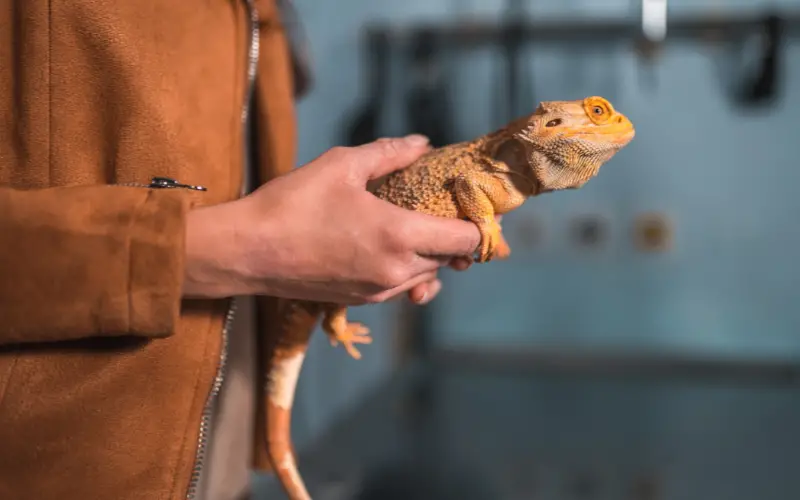
Bearded dragons are popular pet lizards due to their manageable size, docile nature, and relatively easy care requirements. When setting up a tank for your bearded dragon, it is important to consider several factors, such as tank size, temperature regulation, and maintaining a clean environment.
A bearded dragon’s tank should be large enough to accommodate the lizard comfortably as it grows, with a minimum recommended size of 40 gallons for a single adult. However, it is always better to provide a larger tank if possible, as larger habitats allow your pet more room to move, explore, and regulate their body temperature.
Be sure also to include appropriate hiding spots to help your bearded dragon feel secure from potential predators.
Temperature regulation is vital for bearded dragons, as they rely on external heat sources to maintain their body temperature. A basking area should be provided at one end of the tank, with a temperature of around 95-110°F (35-43°C). The other end of the tank should have a cooler area with temperatures ranging between 75-85°F (24-29°C) during the day.
You can achieve proper temperature regulation using heat lamps and ceramic heat emitters. Additionally, placing thermometers and hygrometers in different areas of the tank will help you monitor and maintain the appropriate temperature and humidity levels.
When it comes to tank maintenance, bearded dragons are relatively low-maintenance pets. Their tanks should be cleaned regularly, with waste removal on a daily basis and a thorough cleaning every month. You should use a reptile-safe disinfectant and replace the substrate frequently to maintain a hygienic environment for your pet.
In summary, providing the correct tank setup and environment is essential for the well-being of your bearded dragon. A properly-sized tank, temperature regulation, and clean living spaces are key components to ensure your pet thrives and enjoys a healthy life.
Conclusion: What Size Tank for Bearded Dragons

